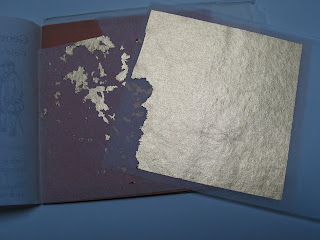Ahhh...the scent of printers' ink and press wash....nothing quite like it. The plates arrived and after checking them over, I cut them apart and started planning the printing. I decided to print the full page images first, and spent the rest of the afternoon cutting up paper. I found there was only just enough, as after ordering, I had decided to include an extra image. Oops! I shall have to be extra careful.

The plates for the images have some larger solid printed areas which made adjustments necessary. My old table-top Craftsman press was built as a jobbing press, for printing small jobs such as tickets, and invitations. Because of its clamshell action, it is not ideally suited for printing large solid areas, not usually an issue for me. So for these images, I had to make several adjustments to rollers, ink and packing in order to get the solid black areas to print well. I then had to print with my full weight on the handle to get enough pressure. I printed dry on this handmade 30 gsm Japanese paper, as I didn't want to spoil the beautiful surface by dampening it. Anyway, the alterations worked. Looking at the handle of this press, which has been welded at some time in its career, my guess is that I'm not the first to throw my full weight on it. I just hope it holds out.

The text printing went well, the damp paper gives a lovely crisp impression and again, as this was the Griffen Mill handmade paper I proceeded extra slowly and carefully. This paper has a watermark in the corner of each sheet, with the letters GM, the infinity sign (to indicate its archival status) and the initials MG for Mike Gibbs, the papermaker. I love the thought that I'm making a book with paper made by a real person, a person I have actually met, and that the paper could last for hundreds of years. I have a bible dating back to 1589, in the reign of Queen Elizabeth I. It is beautifully printed, the presswork is amazing and although it is pretty beaten up, still an object of my admiration for the skill that went into making the paper and printing it all those 400+ years ago.
Because the paper had been dampened I let it dry off a little and when it showed signs of curling, finished the drying process between blotters under a light weight.
During the time I was printing, my leather arrived! I had chosen it from a swatch on a card, so was not really surprised to find that it was slightly different in colour from what I had expected. One batch of leather never dyes the same as the next, it's a fact of life. This skin was a little brighter and redder than I expected, but still a very nice skin, as you can see.
















































